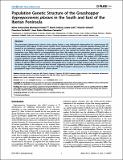Por favor, use este identificador para citar o enlazar a este item:
http://hdl.handle.net/10261/123109COMPARTIR / EXPORTAR:
 SHARE SHARE
 CORE
BASE CORE
BASE
|
|
| Visualizar otros formatos: MARC | Dublin Core | RDF | ORE | MODS | METS | DIDL | DATACITE | |

| Título: | Population Genetic Structure of the Grasshopper Eyprepocnemis plorans in the South and East of the Iberian Peninsula |
Autor: | Manrique-Poyato, María Inmaculada CSIC; López-León, María Dolores; Gómez, Ricardo; Perfectti, Francisco; Camacho, Juan Pedro M. | Fecha de publicación: | 8-mar-2013 | Editor: | Public Library of Science | Citación: | PLoS ONE 8(3): e59041 (2013) | Resumen: | The grasshopper Eyprepocnemis plorans subsp. plorans harbors a very widespread polymorphism for supernumerary (B) chromosomes which appear to have arisen recently. These chromosomes behave as genomic parasites because they are harmful for the individuals carrying them and show meiotic drive in the initial stages of population invasion. The rapid increase in B chromosome frequency at intrapopulation level is thus granted by meiotic drive, but its spread among populations most likely depends on interpopulation gene flow. We analyze here the population genetic structure in 10 natural populations from two regions (in the south and east) of the Iberian Peninsula. The southern populations were coastal whereas the eastern ones were inland populations located at 260-655 m altitude. The analysis of 97 ISSR markers revealed significant genetic differentiation among populations (average GST = 0.129), and the Structure software and AMOVA indicated a significant genetic differentiation between southern and eastern populations. There was also significant isolation by distance (IBD) between populations. Remarkably, these results were roughly similar to those found when only the markers showing low or no dropout were included, suggesting that allelic dropout had negligible effects on population genetic analysis. We conclude that high gene flow helped this parasitic B chromosome to spread through most of the geographical range of the subspecies E. plorans plorans. © 2013 Manrique-Poyato et al. | Versión del editor: | http://dx.doi.org/10.1371/journal.pone.0059041 | URI: | http://hdl.handle.net/10261/123109 | DOI: | 10.1371/journal.pone.0059041 | Identificadores: | doi: 10.1371/journal.pone.0059041 issn: 1932-6203 |
| Aparece en las colecciones: | (CABIMER) Artículos |
Ficheros en este ítem:
| Fichero | Descripción | Tamaño | Formato | |
|---|---|---|---|---|
| Population_Genetic_Structure_ManriquePoyato.pdf | 337,2 kB | Adobe PDF |  Visualizar/Abrir |
CORE Recommender
PubMed Central
Citations
8
checked on 26-abr-2024
SCOPUSTM
Citations
18
checked on 24-abr-2024
WEB OF SCIENCETM
Citations
15
checked on 28-feb-2024
Page view(s)
252
checked on 23-abr-2024
Download(s)
239
checked on 23-abr-2024

